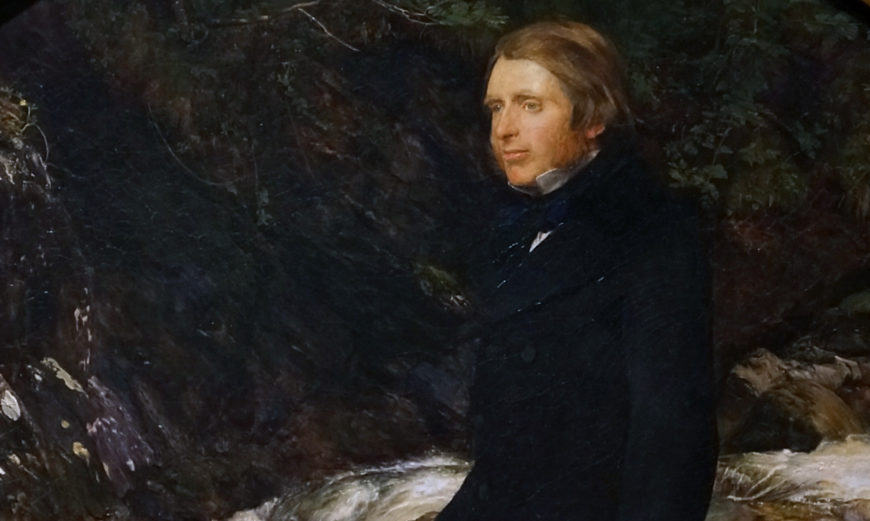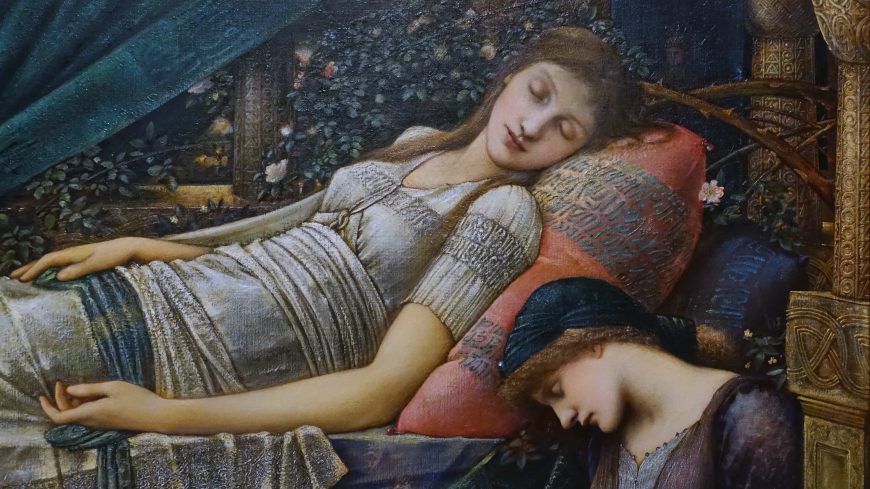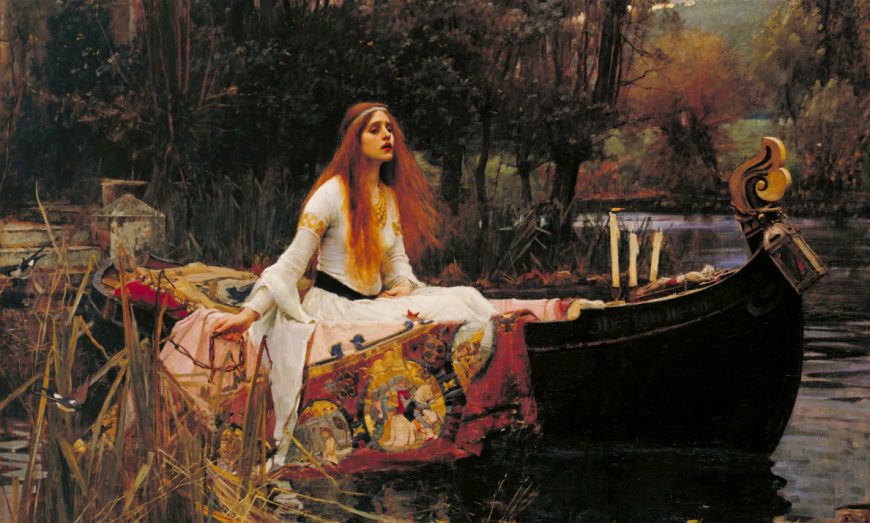The botanical accuracy of this painting is impressive, but its production wasn’t without its challenges for Millais.
Sir John Everett Millais, Ophelia, 1851–52, oil on canvas, 76.2 x 111.8 cm (Tate Britain, London). Speakers: Dr. Beth Harris and Dr. Steven Zucker
[music]
0:00:06.5 Dr. Beth Harris: We’re in Tate Britain looking at the beautiful painting of Ophelia by John Everett Millais. Ophelia is a character in Shakespeare’s Hamlet.
0:00:16.5 Dr. Steven Zucker: The scene that we’re looking at takes place after Hamlet murders Ophelia’s father. And she’s driven mad, and in that madness, lets herself drown. It’s that moment where she’s both buoyant and sinking.
0:00:31.1 Dr. Beth Harris: Her clothes spread wide, grow wetter and wetter and heavier and heavier as she sinks, as she flows down the river to her death.
0:00:40.4 Dr. Steven Zucker: Look at the way that her head is back. Her mouth is slightly open, her eyes are half-closed, her hands, palm up, float in the water, and her hair becomes undone and spreads out across the water. It seems as if there’s no tension in her body. She’s given herself up to the river. And look at the color of that dress. It’s silvery, and it has almost the slightest hint of a purple, that works so beautifully against the brilliant greens that surround her. Notice the way that Ophelia is framed not only by the river, but by this dense foliage that is picked out with an extraordinary amount of specificity. There’s a level of detail, not only Ophelia’s features, not only her dress and the flowers that she holds, but all of the undergrowth on both sides of the river.
0:01:29.9 Dr. Beth Harris: This was really what was important about the new movement of Pre-Raphaelitism, of which Millais was a part. This was a group of artists founded in 1848, who were determined to change, to revolutionize British art. And one way of doing that was to dispense with received wisdom, with received formulas for how to paint, and instead to look carefully for themselves and bring a kind of individual vision and earnestness and seriousness to painting. And Millais does paint the background for this out of doors, which was a new development at this early moment, at around 1850 in England.
0:02:15.0 Dr. Steven Zucker: It might be hard in the 21st century to get a sense of how radical this painting would have seemed in its specificity, in its color, in the representation that is possible because the artist was outside. The traditional academies of Europe were teaching a style of painting that idealized, that generalized, and that relied on formulas. Instead, here’s an artist who’s confronting nature directly and trying to find a way to represent what he sees.
0:02:42.8 Dr. Beth Harris: Painting a canvas out of doors is no easy thing. We have an account of the difficulties from Millais himself. He wrote, “I sit tailor-fashion under an umbrella throwing a shade scarcely larger than a halfpenny for 11 hours, with a child’s mug within reach to satisfy my thirst from the running stream beside me. I am threatened with a notice to appear before a magistrate for trespassing in a field and destroying the hay. I am also in danger of being blown by the wind into the water, and becoming intimate with the feelings of Ophelia when that lady sank to her muddy death. Together with the less likely total disappearance through the voracity of flies, there are two swans who do not a little add to my misery by persisting in watching me from the exact spot I wish to paint. Certainly the painting of a picture under such circumstances would be a greater punishment to a murderer than a hanging.”
0:03:37.3 Dr. Steven Zucker: It’s so funny, because we’re looking at this painting that is all about the beauty of nature, the tragedy of Ophelia. And yet here’s the artist, dealing with the most mundane difficulties. It’s hot. There are flies. He’s worried about falling in, and then he’s got these two damn swans.
0:03:53.5 Dr. Beth Harris: When we look at this, we’re keenly aware of the importance of plant life, of nature, of the fallen tree in the background that in its horizontal form mimics the form of Ophelia herself. But then those upright reeds that the light passes through, casting shadows on the surface of the water, these beautiful passages and intense coloration draw us into the multiplicity of nature.
0:04:22.8 Dr. Steven Zucker: There is no sky. The result is that we have an enclosed, quiet, private space. The only reference to sky can be seen in the lower left corner, where we see just a little bit of blue and a little bit of clouds in the quiet surface of the water, an area that is protected from the current by the reeds beside it. It’s interesting to note that at the very moment that the Pre-Raphaelites are emphasizing a kind of almost microscopic detail, there is simultaneously a revolution taking place in the way images are produced. The mid-19th century saw the explosion of the new technology of photography.
0:05:01.9 Dr. Steven Zucker: And one of the pioneers of English photography was William Henry Fox Talbot, who, just a few years before this painting was made, in an address to the public, said, “One advantage of the photographic art will be, that it will enable us to introduce into our pictures a multitude of minute details which add to the truth of the representation, but which no artist would take the trouble to copy faithfully from nature. Contenting himself with a general effect, he would probably deem it beneath his genius to copy every accident of light and shade, nor could he do so without a disproportionate expenditure of time and trouble.” And yet, here we see Millais taking that time and trouble, 11 hours a day on the edge of this river, making sure that every reed, that every flower, that every leaf is carefully delineated.
0:05:51.0 Dr. Beth Harris: It’s interesting to think about this period that Carlyle referred to as the Mechanical Age, and yet the Pre-Raphaelite artists are attempting to bring a kind of deeply felt poetry to their art, in a way, as a corrective to an age that felt mechanical, that felt mass-produced, and to bring a kind of sincerity and individual vision to their art.
[music]
A Pre-Raphaelite masterpiece
Ophelia is considered to be one of the great masterpieces of the Pre-Raphaelite style. Combining his interest in Shakespearean subjects with intense attention to natural detail, Millais created a powerful and memorable image. His selection of the moment in the play Hamlet when Ophelia, driven mad by Hamlet’s murder of her father, drowns herself was very unusual for the time. However, it allowed Millais to show off both his technical skill and artistic vision.
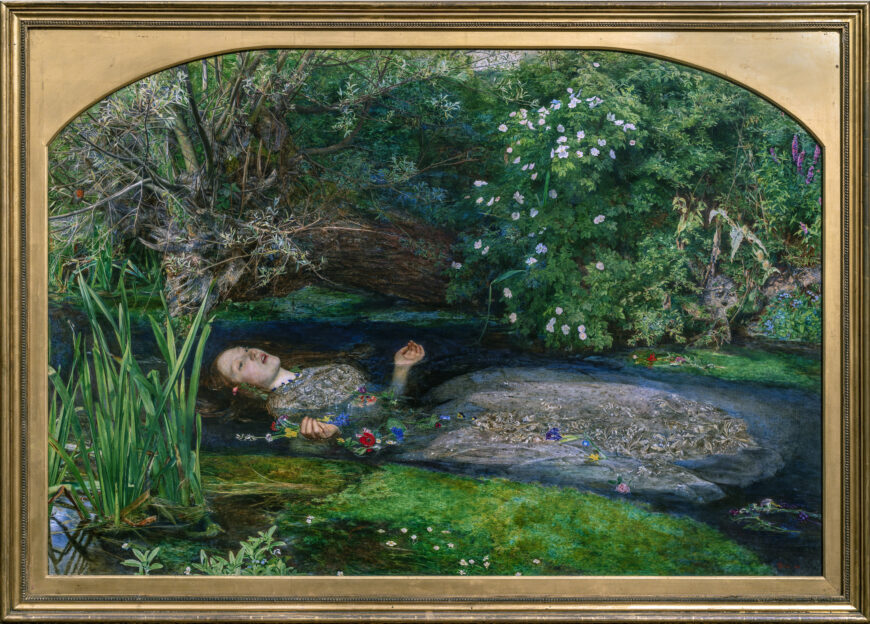
John Everett Millais, Ophelia, 1851–52, oil on canvas, 76.2 x 111.8 cm (photo: Steven Zucker, CC BY-NC-SA 2.0; Tate Britain, London)
The figure of Ophelia floats in the water, her mid section slowly beginning to sink. Clothed in an antique dress that the artist purchased specially for the painting, the viewer can clearly see the weight of the fabric as it floats, but also helps to pull her down. Her hands are in the pose of submission, accepting of her fate.
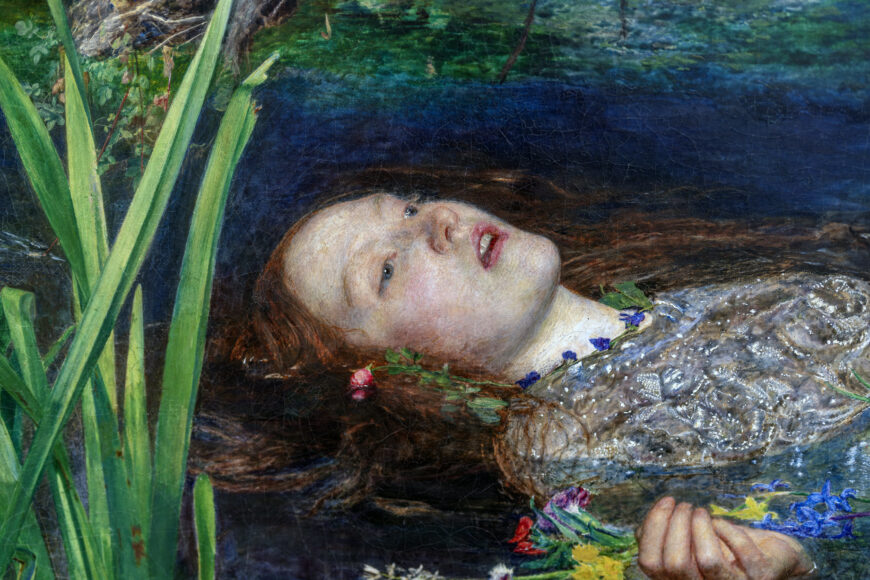
John Everett Millais, Ophelia, 1851–52, oil on canvas, 76.2 x 111.8 cm (photo: Steven Zucker, CC BY-NC-SA 2.0; Tate Britain, London)
She is surrounded by a variety of summer flowers and other botanicals, some of which were explicitly described in Shakespeare’s text, while others are included for their symbolic meaning. For example, the ring of violets around Ophelia’s neck is a symbol of faithfulness, but can also refer to chastity and death.
The hazards of painting outdoors
Painted outdoors near Ewell in Surrey, Millais began the background of the painting in July of 1851. He reported that he got up everyday at 6 am, began work at 8, and did not return to his lodgings until 7 in the evening. He also recounted the problems of working outdoors in letters to his friend Mrs. Combe, later published in the biography of Millais by his son J.G. Millais.
“I sit tailor-fashion under an umbrella throwing a shadow scarcely larger than a halfpenny for eleven hours, with a child’s mug within reach to satisfy my thirst from the running stream beside me. I am threatened with a notice to appear before a magistrate for trespassing in a field and destroying the hay.”
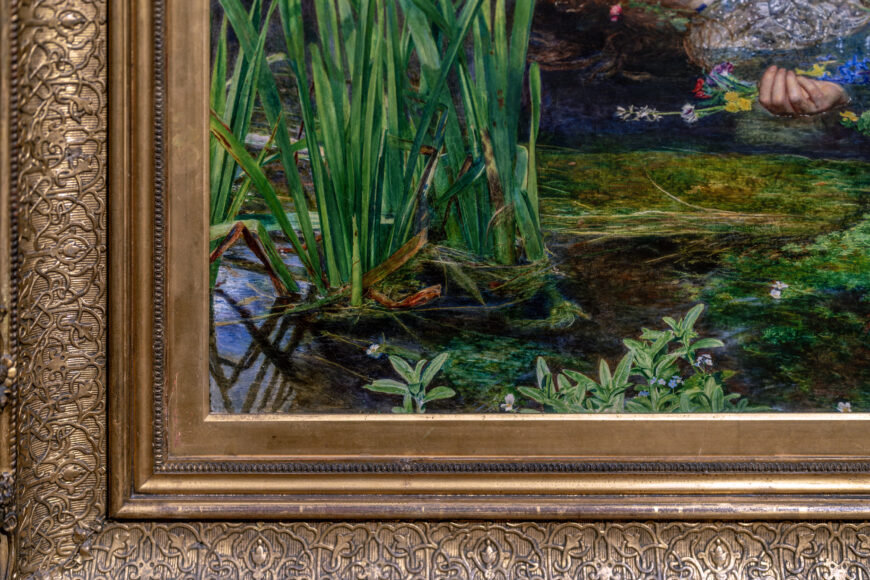
John Everett Millais, Ophelia, 1851–52, oil on canvas, 76.2 x 111.8 cm (photo: Steven Zucker, CC BY-NC-SA 2.0; Tate Britain, London)
The hazards of being an artist’s model

Dante Gabriel Rossetti, Elizabeth Siddal painting at an easel, pencil on paper, 1850s, 25 x 20.3 cm (private collection)
His problems did not end when he returned to his studio in mid-October to paint the figure of Ophelia. His model was Elizabeth Siddal who the Pre-Raphaelite artists met through their friend Walter Howell Deverell, who had been impressed by her appearance and asked her to model for him.
When she met the Pre-Raphaelites Siddal was working in a hat shop, but she later became a painter and poet in her own right. She also become the wife and muse of Dante Gabriel Rossetti. Millais had Siddal floating in a bath of warm water kept hot with lamps under the tub. However, one day the lamps went out without being noticed by the engrossed Millais. Siddal caught cold, and her father threatened legal action for damages until Millais agreed to pay the doctor’s bills.
Millais becomes a success
Ophelia proved to be a more successful painting for Millais than some of his earlier works, such as Christ in the House of his Parents. It had already been purchased when it was exhibited at the Royal Academy in 1852. Critical opinion, under the influence of John Ruskin, was also beginning to swing in the direction of the PRB (the Pre-Raphaelite Brotherhood). The following year, Millais was elected to be an Associate of the Royal Academy, an event that Rossetti considered to be the end of the Pre-Raphaelite Brotherhood.
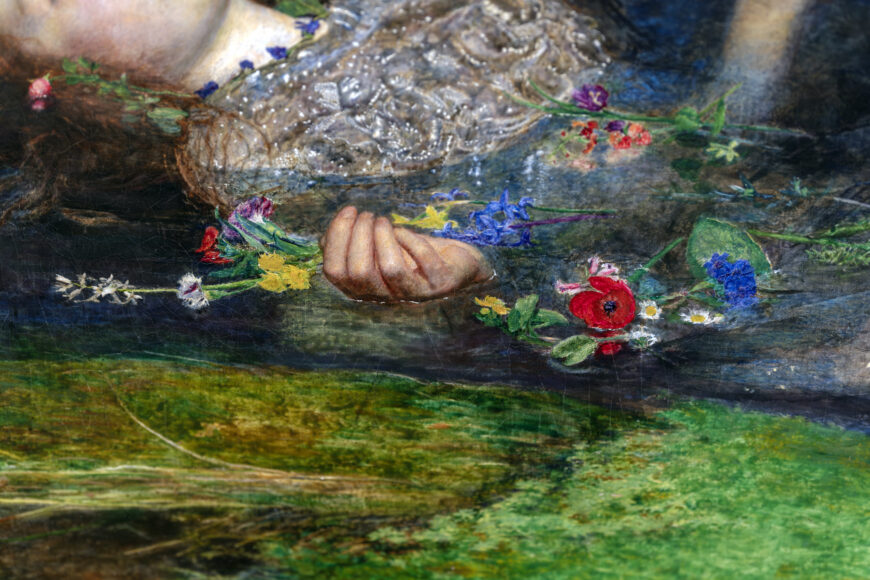
John Everett Millais, Ophelia, 1851–52, oil on canvas, 76.2 x 111.8 cm (photo: Steven Zucker, CC BY-NC-SA 2.0; Tate Britain, London)
The execution of Ophelia shows the Pre-Raphaelite style at its best. Each reed swaying in the water, every leaf and flower are the product of direct and exacting observation of nature. As we watch the drowning woman slowly sink into the murky water, we experience the tinge of melancholy so common in Victorian art. It is in his ability to combine the ideals of the Pre-Raphaelites with Victorian sensibilities that Millais excels. His depiction of Ophelia is as unforgettable as the character herself.
Excerpt from Shakespeare, Hamlet, Act IV, Scene VII:
There, on the pendent boughs her coronet weeds
Clambering to hang, an envious sliver broke;
When down her weedy trophies and herself
Fell in the weeping brook. Her clothes spread wide,
And, mermaid-like, awhile they bore her up;
Which time she chanted snatches of old tunes,
As one incapable of her own distress,
Or like a creature native and indued
Unto that element; but long it could not be
Till that her garments, heavy with their drink,
Pull’d the poor wretch from her melodious lay
To muddy death.


